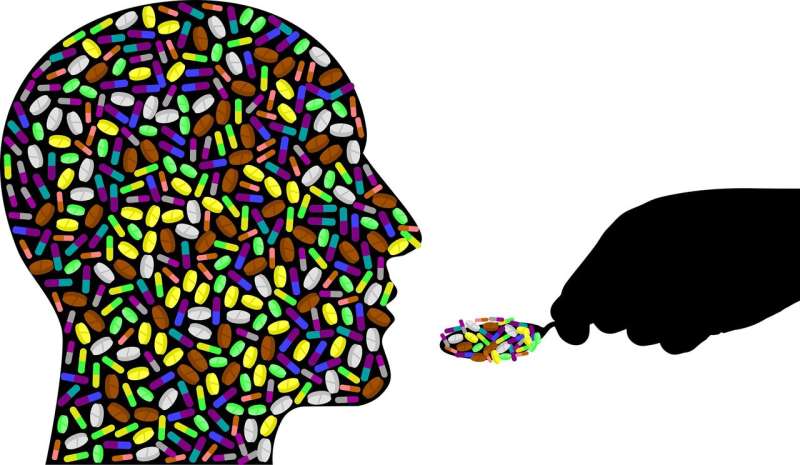Efforts to reduce opioid prescriptions may be hindering end-of-life pain management

Policies designed to prevent the misuse of opioids may have the unintended side effect of limiting access to the pain-relieving drugs by terminally ill patients nearing the end of their life, new research led by the Oregon State University College of Pharmacy suggests.
A study of more than 2,500 hospital patients discharged to hospice care over a nine-year period showed a decreasing trend of opioid prescriptions as well as an increase in the prescribing of less powerful, non-opioid analgesics, meaning some of those patients might have been undertreated for their pain compared to similar patients in prior years.
The findings, published in the Journal of Pain and Symptom Management, are an important step toward optimizing pain management and minimizing the suffering of dying patients. Hospice care refers to treatments whose goal is to maximize comfort and quality of life as opposed to prolonging life.
Researchers at OSU, Oregon Health & Science University, the Dana Farber Cancer Institute and Ariadne Labs in Boston, the University of Massachusetts Medical School and the University of Maryland School of Pharmacy used electronic health record data to examine 2,648 discharges of adult patients to hospice care.
The discharges were from an acute care, academic hospital between Jan. 1, 2010, and Dec. 31, 2018. The average patient age was 65, more than half had cancer, and the study sought to determine the year by year frequency of patients receiving opioid prescriptions.
After adjusting for factors that could affect prescription frequency, including age, specific diagnosis and where the patient was to receive hospice care, the results showed a nearly 12% downward trend from the first year (91.2%) to the last (79.3%).
"Pain is a common end-of-life symptom and it's often debilitating," said the study's lead author, Jon Furuno, an associate professor and the interim chair of the Oregon State Department of Pharmacy Practice, who notes that more than 60% of terminal cancer patients report "very distressing pain."
Opioids, a class of drugs that block pain signals between the body and brain, are an effective pain management tool. But there are barriers, Furuno said, to the optimal prescribing of opioids.
Among the hurdles are timely and accurate pain assessments, patient and caregiver concerns regarding addiction, and caregiver concerns about making mistakes in administering the meds. Additional obstacles are policies and practices aimed at limiting opioid use in response to the opioid epidemic.
Traced to over-prescribing that began in the 1990s, the epidemic claims more than 40,000 American lives annually, according to the U.S. Department of Health and Human Services. Ten million people a year misuse prescription opioids and 2 million suffer from an opioid use disorder. Opioids can be highly addictive and they exist both as prescription painkillers like morphine, hydrocodone, fentanyl and oxycodone and street drugs such as heroin.
Five years ago, the Centers for Disease Control and Prevention produced a guideline for prescribing opioids for chronic pain, and there have been several other federal, state and local efforts over the last 10 years to curb opioid prescribing, Furuno said.
"There are some concerns, however, that indiscriminate adoption or misapplication of these initiatives may be having unintended consequences," he said. "The CDC Prescribing Guideline and the other initiatives weren't meant to negatively affect patients at the end of their lives, but few studies have really looked at whether that's happening. Our results quantify a decrease in opioids among patients who are often in pain and for whom the main goal is comfort and quality of life."
Furuno adds that the concurrent increase in non-opioid analgesic prescriptions suggests health care providers remained concerned about pain management even as they wrote fewer opioid prescriptions.
"Sometimes non-opioids alone are the best choice, or non-opioids in combination with opioids," he said. "But it's important to remember that non-opioids alone are also not without risk and that delaying the start of opioid therapy may be delaying relief from pain.
"Even among patients prescribed opioids during the last 24 hours of their inpatient hospital stay, opioid prescribing upon discharge decreased," Furuno added. "It seems unlikely that patients would merit an opioid prescription on their last day in the hospital but not on their first day in hospice care, and it's well documented that interruptions in the continuity of pain treatment on transition to hospice are associated with poor patient outcomes."
More information: Jon P. Furuno et al, Decreasing Trends in Opioid Prescribing on Discharge to Hospice Care, Journal of Pain and Symptom Management (2021). DOI: 10.1016/j.jpainsymman.2021.03.025



















